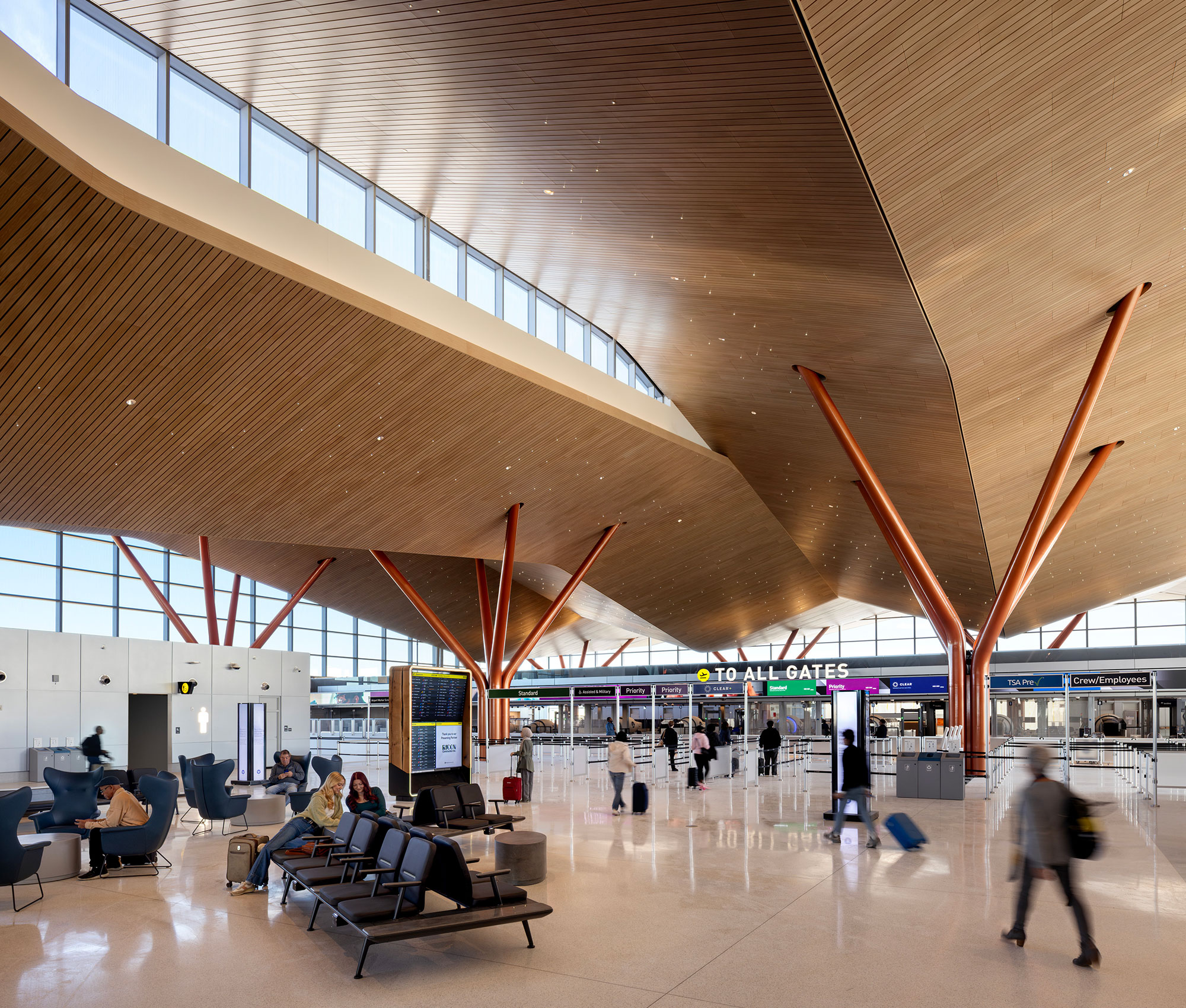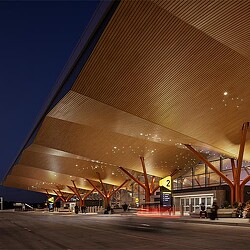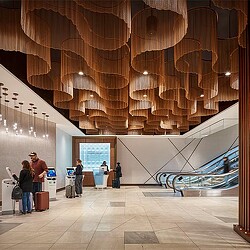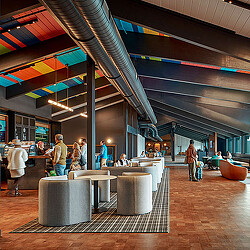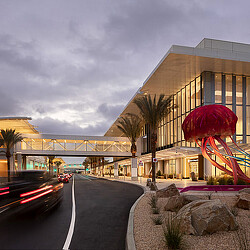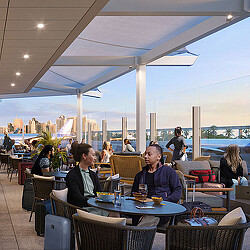Designing the Future of Travel at Pittsburgh International Airport
Building a terminal rooted in flexibility, passenger experience, and the spirit of a city that’s reinventing itself.

Yesterday, I walked into Pittsburgh International Airport’s new terminal not as an architect on a site visit, but as one of its very first passengers traveling through its new 811,000-square-foot terminal addition. Pulling my roller bag through the entry sequence I’ve studied for years, passing the tree-like columns I’ve watched rise from foundation to form, and looking up at a roofline inspired by the rolling hills of Western Pennsylvania, I was able to experience a place I once only imagined on paper.
It was a surreal moment. Full circle. And deeply personal.
This terminal has been a part of my life for years; a project big and important enough that I moved my family to Pittsburgh for it. You can’t helicopter into a project like this. You have to live it. You have to understand the people it serves, immerse yourself in the culture, and let the city shape the design just as much as the design shapes the city.
Finding a Home in Pittsburgh
When I first landed in Pittsburgh about seven years ago, I had already lived in Washington, D.C., New York, London, and Chicago. I thought I understood cities. But Pittsburgh surprised me.
This city welcomed my family and me with open arms. What struck me most was the strength of the social fabric — the way people feel deeply connected to the institutions that have shaped their lives, from universities and medical centers to arts organizations and philanthropic foundations. There is a pride here that isn’t performative or fleeting. It’s rooted.
Over time, I came to understand something essential about Pittsburgh: its defining story is one of transformation. From pioneering steel to advancing robotics, from industrial powerhouse to global innovation hub, this region has reinvented itself again and again. And its airport — its literal gateway to the world — should reflect that same resilience, ambition, and warmth.
That understanding guided every decision we made.
Designing the Airport Pittsburgh Deserves
When this project began, the existing terminal (an early-’90s mega-hub built for US Airways) no longer reflected Pittsburgh’s origin-and-destination travel patterns or its future. CEO Christina Cassotis recognized the moment and championed a bold idea: build an airport for Pittsburghers.
For our design team — Gensler + HDR in association with luis vidal + architects — this vision required more than architectural expertise. It required cultural immersion.
Led by the Allegheny County Airport Authority, we toured neighborhoods, met with community leaders, and explored the places that make Pittsburgh… Pittsburgh. The bridges and river valleys. The museums and maker spaces. The cultural institutions, the colors of the hillsides, the cookie tables.
These conversations and experiences shaped the entire project’s design ethos.
A Frictionless Journey
Airports can be stressful. People worry about timing, wayfinding, security lines, and whether their bags will follow them home. Our goal was simple: to design a journey so intuitive and seamless that people can get to their gate without uncertainty.
New roadways and a 1,300-foot terminal front bridge improve traffic and reduce congestion. Separate levels for arrivals and departures smooth the flow of people, allowing passengers to see where they are going before they get there. A unified 12-lane security checkpoint removes the uncertainty of the two previously separated checkpoints, where queuing protocols changed frequently. Instead of nervously checking for a driver’s license at the security checkpoint, there’s a warm sendoff area where passengers can take a beat before security to get together what they need before entering the queue.
But here’s the great part: by creating an experience that feels more intuitive and less stressful, we were able to make room for moments of reflection and a travel experience that feels calmer and more human.
Built for People
Airports aren’t just for passengers; they are workplaces for thousands of employees who keep every operation running day after day. We designed this terminal to honor them, too.
“We design for great passenger experiences, but we also need to design great employee experiences,” I remind colleagues. Saving employees five minutes when walking from their position in the terminal to a breakroom is huge. Designing back-of-house spaces to support these types of efficient movements is one part of this.
This terminal doesn’t just work better for passengers — it works better for all users.
Uniquely Pittsburgh
Pittsburgh is a city of memorable traditions. We put fries on salads and sandwiches. And we show up at the airport to welcome home friends and family. This is known as the “meeter-greeter” phenomenon, and while it has waned in other cities, it’s still an essential part of this region’s culture.
To support this, the new terminal offers large meter-greeter zones with generous seating, special food locations, and access to terraces. Most importantly, there is also great visibility to arriving passengers.
Supporting the meter-greeter is just one example of how this terminal is uniquely Pittsburgh. At every turn throughout the building, the architecture celebrates the region:
- Tree-like steel columns evoke Western Pennsylvania forests.
- Undulating rooflines mirror the Allegheny foothills.
- Constellation ceiling lighting recalls the region’s star-filled skies.
- Locally sourced steel, stone, and wood root the terminal in the city’s material heritage.
- Over 80% of art installations come from Pittsburgh-area artists.
Every moment, from the terrazzo patterns at your feet to the shadows cast across the floors, was designed to feel like this region and nowhere else.

Rooted in the Landscape of Western Pennsylvania
One of the clearest ways I’ve come to describe this building is as a pavilion shaped by the landscapes and heritage of Pennsylvania — its forests, its terrain, and its enduring sense of place.
Four terraces — two pre-security, two post-security — will feature plants native to Pittsburgh’s diverse ecoregions. The roof’s rolling geometry creates shelter and spatial rhythm. Warm metal ceilings mimic wood without warping, balancing practicality with beauty.
Sustainability is embedded everywhere. A rainwater capture system irrigates terrace landscapes. Energy systems are efficient and future-ready. The project is tracking toward LEED Gold.
In every sense, the building is designed for longevity, for Pittsburgh today and tomorrow.

A Personal Reflection
Leading this project has been one of the greatest honors of my career. Not only because of the complexity or scale, but because of what it represents: Pittsburgh’s belief in itself and its future.
Over the last seven years, this city has become home. I’ve seen firsthand how innovation, resilience, and community define this region. Designing this terminal has allowed me to contribute to a story much bigger than architecture — a story about identity, belonging, and progress.
Yesterday, when I entered the terminal as a guest for the first time, I felt an overwhelming sense of pride. Pride in our teams. Pride in this city. Pride in knowing that we created a gateway that reflects the soul of Pittsburgh.
It’s a moment I’ll never forget.
For media inquiries, email .

